


Edward Partleton (c1782-1845)
Frustratingly we don't have Edward's birth record, but from other information we know that he was born in 1782 near Whitehaven.
First we need to find our bearings; where is Whitehaven?:

Whitehaven is in the north-west of England, in the old county of Cumberland.
Now that we know where we are, we can zoom in closer, because we know that Edward grew up in the village of Hensingham, a mining area, which we see circled red in the map below of 1818:

Edward was the eldest of nine children as we can see in the tree below:

Two years after Edward's birth, we find the birth record of his sister Catherine at Hensingham on 17 March 1784. Apologies for the poor quality of this image which I took with my mobile phone from a microfilm viewer at the LDS centre in London:
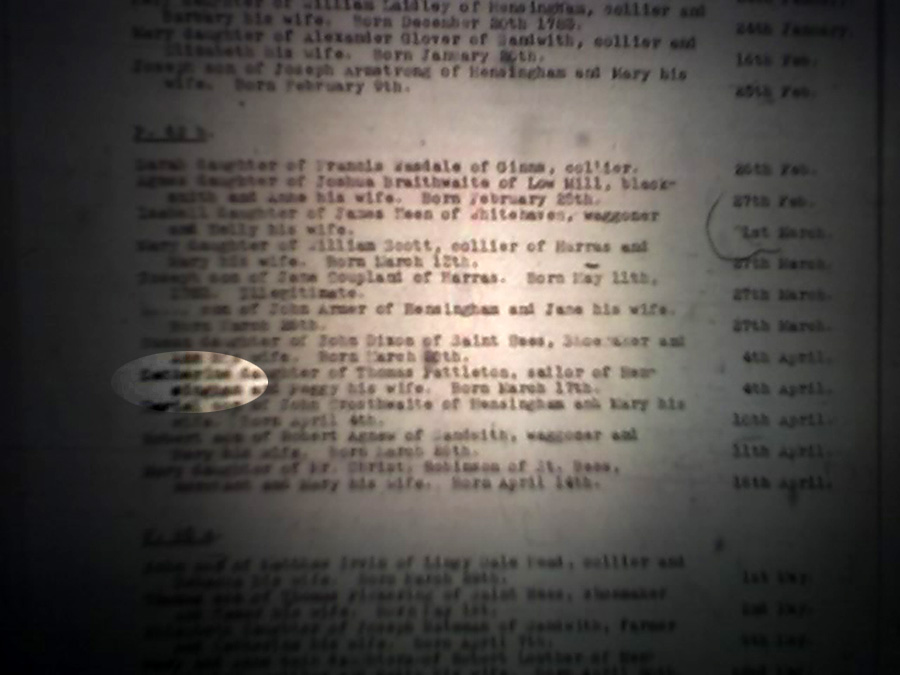
Edward's dad Thomas 'Pattleton' is a sailor at this time, a job which he alternates with being a coal miner. His mum Margaret had been known as Peggy - indeed was Peggy Lee before her marriage. The christening is recorded at St Bees - a name which appears on many of the early Partleton birth records in Cumberland. In fact it appears on so many records that it's worth making a small diversion for a moment to understand exactly what St Bees is.
We should be clear that the family were not living in the village of St Bees, a tiny place which we see circled in yellow in the map below. Nor are they being born at St Bees Head, the nearby promontory with the lighthouse in the map. St Bees appears on the birth records because the baby's birth fell within the ecclesiastical jurisdiction of the old Priory of St Bees, which covered most of the surrounding part of Cumberland, including Whitehaven.

The Priory of St Bees (originally St Bega) was founded by the Normans in c1120 as a part of their programme of strengthening their grip on the northern part of Britain subsequent to their invasion at Hastings. We tend to think that the Normans came in 1066 and then that was that, but in reality the conquest took decades, especially in the north where they met frequent resistance. They meted out violent revenge in the Harrying of the North during the 1070s and 1080s. Hundreds of thousands were killed and the land was literally scorched bare.
Land in Cumberland is not listed in the Domesday Book, the great land-register created by the Normans in 1086. Why? Because at that time most of Cumberland was part of Scotland. Not a lot of people know that. The Normans had trouble with the Scots, and in 1092 Cumberland was invaded by William the Conqueror's son, King William Rufus, and he created the Earldom of Carlisle to govern it. The Scots won it back between 1135 and 1157 during The Anarchy in England, but the England/Scotland border was finally made permanent under the Treaty of York in 1237.
419 years after its foundation, on 16 October 1539, the priory, amidst the same fate as all other priories in England, fell victim to the dissolution of the monasteries by Henry VIII. In the engraving below of the 1730s, we see the priory falling into ruin:
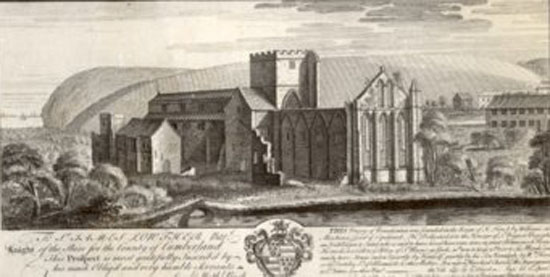
This is roughly how it would have appeared to our Edward. He lived for some years just a mile or two north of this ruin; there's little doubt he would have seen it many times.
By 1815 the priory was crumbling further as we see below:

More walls collapsed until 1855 when St Bees was restored as a church, incorporating some of the medieval building.
Back to Edward. In 1786, 1788 and 1789 he gets three little brothers; Thomas, John, and George, all born at Hensingham; and in 1791 a fourth - William - and we are rewarded with a little snippet of information from a 1968 publication, The Registers of St Bees, Cumberland:

We learn from this that Edward's dad Thomas Partleton (b1754) is now a collier - a coal miner - which is not a surprise since most of the Partleton family in Cumberland are involved in mining.
Edward's parents are not done yet with having babies. In 1795 Edward gets a sister, Ann, and in 1798, a second brother George - a sure sign that the earlier George who had been born in 1789 had died in childhood.
Finally, in 1802, Edward, who is now 20, gets a baby sister Margaret, and again we have a priceless little snippet of information:

Whitehaven was a substantial port in 1802, of much greater importance than it is now. Edward's dad is again recorded as a mariner. Their address is Newtown - the commonest place name in Britain - which is not very helpful. However, I have found it - here it is, circled in purple, located quite close to the harbour on this very useful old map of Whitehaven:

Edward's father's job as a mariner was only temporary, because we know that Edward, his little brother John, aged only 13, and his dad Thomas are all on the payroll of the Howgill Colliery in the year 1802. The Howgill Inclined Plane and Howgill Street are circled in red in the map above:

The Howgill Colliery was located in the southwest of the town of Whitehaven - near to Newtown, as it happens, so we have confirmation that the family are now in Whitehaven. And from the same publication, Transactions of the Cumberland & Westmorland Antiquarian & Archeological Society (1970), we learn that Edward was 20 which places his birth as 1782, and we also discover what his job was:

He's a hagger. Great, that's cleared that up then... What's that - you don't know what a hagger is? Well - neither do I, it's an obsolete word, and I have looked it up: HAGGER (N.). One who is employed in cutting or hewing coal in a coal mine. So Edward is right at the coal face, straining his eyes by the light of a dangerous naked flame, choking in the dust, and hacking away with a pick.
 Left: A coal miner - not our Edward, of course
Left: A coal miner - not our Edward, of course
We move on one year and it is time for Edward to be wed:

Yes, indeed, his marriage appears to be recorded under the name of Partington, but we are going to see a whole lot of this.
Edward is really not fussy how his name is spelled, or - more significantly - pronounced, and he passes this relaxed disposition to his children who grow up equally ambivalent. They use both Partleton and Partington interchangeably in the first half of the 19th century, at a time when some of their cousins in Cumberland are using only Partleton.
By the end of the 1800s, all of Edward's descendants have dropped the name Partleton completely in favour of Partington.
So... we are going to see a whole lot of evidence that Edward Partington is Edward Partleton and vice-versa - so much so that there can be little doubt that he's one and the same person.
Let's start with Edward's family. He and Elizabeth Davis have eight children to our knowledge:

There were probably more kids; witness that six-year gap from 1803 to 1809 which may be significant later on.
The wedding was only just in time; Elizabeth was 7 months pregnant on her wedding day, 03 September 1803. Their son John was born on 31 October and baptised on 11 November as John Partington:

The next child - Davis - is so-called after his mum's maiden surname.

Davis's unusual forename gives us a perfect opportunity to explore the Partleton / Partington dichotomy.
Although he was baptised as Davis Partington, when he is married in 1833, he declares himself as Davies Partelton, as we see below:

In the 1841 census he is unmistakably Davies Partleton:

In the 1851 census we find him as Davis Parlington. That's a new one, unless the enumerator has forgotten to cross his 't':

And Davis continues to record his surname as Partington until his death in 1874.
Let's go back to the subject of the page, Edward Partleton, because on the above census sheet, under 'Where Born', Davis has given us a clue as to exactly where his dad Edward was living in 1809: the New Houses.
The New Houses were notorious slums, arguably the worst in Britain, built at absolutely minimum cost in 1788 by William Lowther, the owner of Whitehaven's coal mines, to accommodate his workers. We can see the New Houses as three rows of houses built into a steeply-sloping bank, circled in green in the map below

The New Houses survived until the late 1930s when these slums were finally cleared; some photographs survive. This one is seen from the blue arrow in the map:
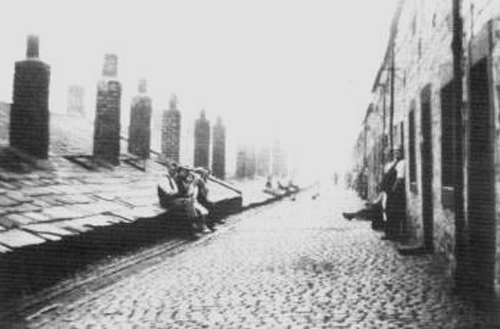
The ground is so steep that the rooves of one row are at ground level with the next. A museum at Whitehaven has built a model of the houses:

The houses had exactly one room upstairs, and one room downstairs, with a tiny kitchen attached. These long rows of terraced dwellings had no sanitation of any kind. Men relieved themselves in the street, slops were ditched against neighbours' back walls.

The picture above was taken in the 1930s, but we may use it to step into Edward's shoes in 1809, because this is exactly the view as he stepped out of his front door. By the time that photo was taken, the "New" Houses were 150 years old, but can still be seen in the 1938 Ordnance Survey map below. At this date the mine owners had added the luxury of one common toilet per six houses - outside, of course.
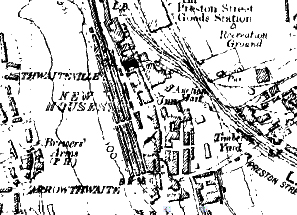 Left:
Ordnance Survey Map, 1938
Left:
Ordnance Survey Map, 1938
The state of life in the New Houses is fully covered in the Partleton Tree page for Edward's brother George who, in later years, also resided there. But the most graphic account of what was to be found was recorded by a reporter of the local newspaper in 1831, following the progress of a coroner's jury, unable to disguise his horror of what he saw:
"They had to pilot their way through those almost interminable rows of squalid cottages called the New Houses and the Ginns, which belong to Lord Lonsdale, and are exclusively occupied by his workmen. None of these buildings seem very modern, and we have rarely seen any dwellings even of the lowest class of artisans so destitute of comfort or convenience. Whether it be from poverty or from improvidence, their interior and exterior, with the exception that they are all carefully whitewashed, are naked, desolate, and filthy in the extreme; a yet more disgusting circumstance was that a large portion of their inmates both male and female, were either intoxicated or in a state bordering on intoxication."
All this points to our Edward, working in Lord Lonsdale's coal mines in 1809, and living in the New Houses, being very poor indeed.
Edward's next child, John, was baptised in 1812:


Baby John is christened as John Partington, but when we find his marriage 21 years later, which we see on the right, he names himself John Partleton.
John was baptised in Holy Trinity church in Whitehaven which is circled yellow in the map below:

 Left: Holy Trinity
Church
Left: Holy Trinity
Church
And here's the interior of the church just as it appeared to Edward for his son John and daughter Margaret's christenings on that November day in 1812:

Attending church in a coal mining area had its hazards. The congregation might fall through the floor, apparently to the hell fire, at any moment. Holy Trinity suffered subsidence because of the coal mines underneath it and was demolished in 1949 due to its potential for collapse. The land is now a public park.
As mentioned above, Edward's first daughter, Margaret, was christened on the same day as her brother John. We don't know the birth date of either of them. They may have been twins, and they may not:

And in 1815, Edward gets his fourth son, Daniel.
For anyone who is still sceptical due to the fact that Edward seems to be forever calling himself and his children Partington, here's baby Daniel's baptism as Daniel Partleton:

The next baby is recorded as Thomas Partington:
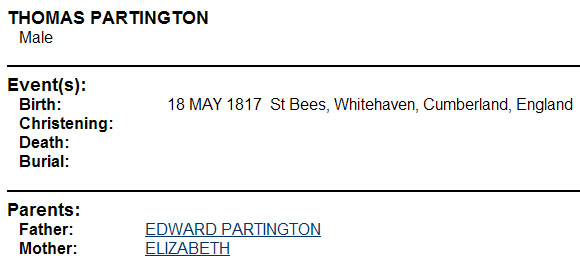
The above Thomas was married in 1843, as we see below. The researcher of the Church of Jesus Christ of Latter-day Saints struggled to match Thomas' inconsistent surnames against his life events, and decided to keep her options open, citing Partington, Partleton and Parthington as variant surnames:

Below we see why - Thomas' wife Catherine Storey is apparently married to Thomas Parthington:

In the 1851 census, we see Thomas under a very interesting amalgamation of the names Partleton and Partington, as he is recorded as Parteryton:
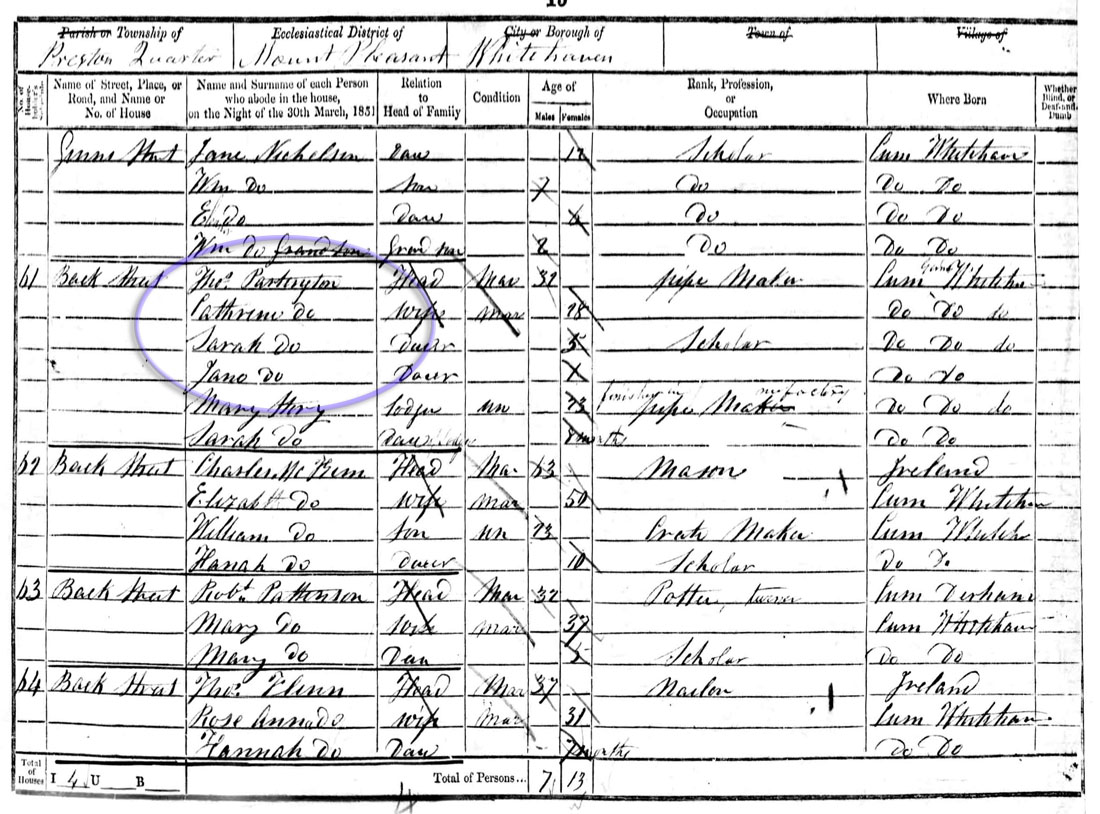
Again we get a pointer as to exactly where Thomas' dad Edward was residing in 1817, if we look closely at Thomas' declared birthplace:

That little word inserted before Whitehaven says 'Ginns', which you may remember being condemned as slums in the newspaper report earlier. The Ginns are named after the mining Engines which are located in this area, circled orange in the map below, right next to the New Houses:

The features circled in the map above can be matched exactly with the wonderful 1840 view of Whitehaven below... 'There's coal in them thar hills':

At the green arrow we see the dreaded New Houses, the orange arrow is The Ginns, the yellow arrow is Holy Trinity Church, and the red arrow shows the Howgill Inclined Plane.
Before that detour we were speaking about Edward's son Thomas. In 1861, now 43 years old, Thomas is again Partington.

He's moved to Egremont, circled in green in the map below. It seems mining is not for him. In 1851 he'd been a pipe maker; now he's a railway porter at Egremont Station.

Egremont Station didn't exist in 1818 when the above map was drawn. Not surprising, since none existed anywhere in the world at that date. The world's first steam railway, the Stockton and Darlington was not built till 1825.
When the Egremont railway was built, in 1855, it was for the purpose of transporting iron ore to the Workington foundries in the north, but it opened to passengers in 1857. So it was very new when Thomas worked there in 1861. The railway was uneconomic for passengers and closed for this purpose in 1935, but continued in use for ore until 1982. The track was then lifted and some of the route is now a cycle path.
Here's a picture of the staff at Egremont Station. I can't date this photograph (perhaps early 1900s?), but although Thomas would certainly recognise the station building, it's probably taken at least 25 years after he worked at this location:
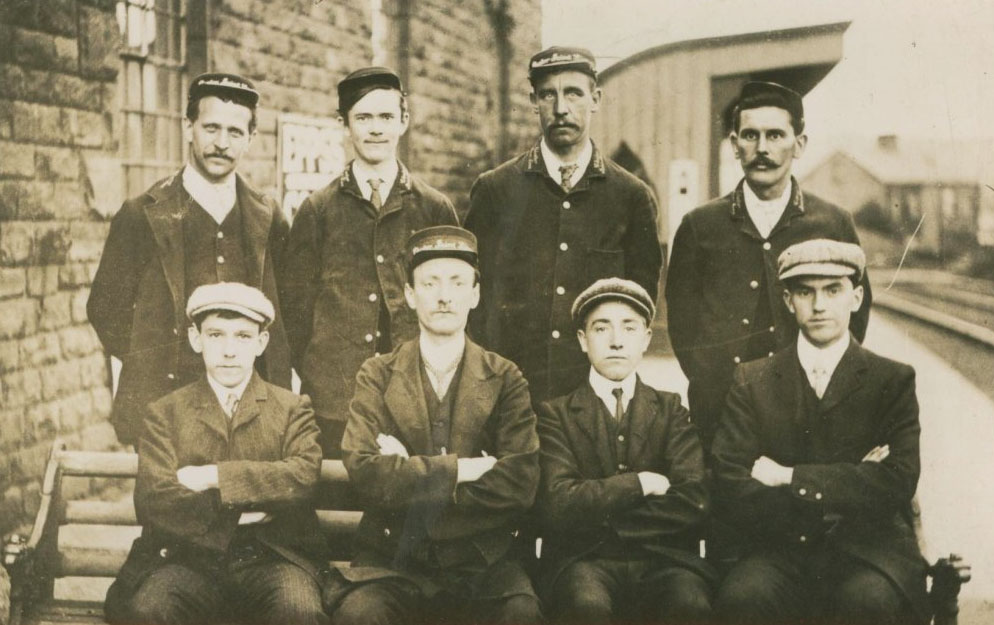
In the 1871 census Thomas is still at Egremont Station, now employed as a railway clerk, and - whatever all those previous records say about Partington - he is still unmistakably calling himself Thomas Partleton:
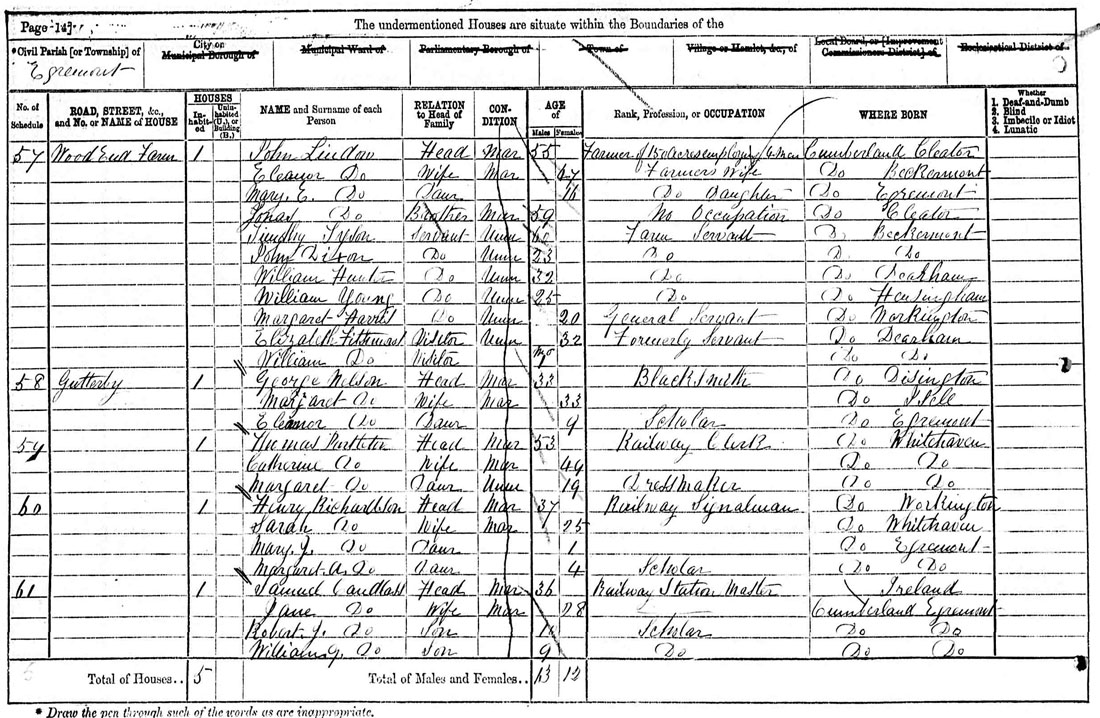
In 1881, Thomas is back again as Partington, and dies in the October quarter of that year. His death, as was his birth, was recorded as Partington.
What does all that name-switching tell us? We should be conscious that it's quite likely that all of the people discussed above were illiterate. Someone else is filling out the forms for them. But I think it also tells us that they weren't that particular about how other people pronounced their name. This phenomenon only happens in Cumberland, and only for some branches of the Partleton family within Cumberland. Other stuck with Partleton.
In London, by contrast, though the name is quite often misspelled or crudely spelled - Parleton, Partletone, Parteton, Puttelon, Parketon, Parkleton, Parselton, Parsleton, Portleton have all been recorded, (and many, many more), they are always clearly mis-spellings or mis-hearings of Partleton, or merely illegible handwriting. The name Partington only ever appears once in London, for orphan Rebecca Ann Partleton, who is being looked after by her uncle and aunt in 1851.
Back to our Edward in Cumberland. He still has two more children for us to record:

Elizabeth was baptised in 1822 as Partington.
Mary, Edward's last child, was baptised in 1824 as Mary Partington. She grows up to be a straw-bonnet maker. In the 1851 census she reveals that she also was born in the New Houses. At the time of her birth, her dad Edward was 42 and had been living in and around the New Houses for at least 15 years.
Four years later, August 12 1828, and we might think that Edward's life as a poor coal miner is progressing steadily towards a predictable and unremarkable finish. But we'd be wrong...

,%20Tuesday,%20August%2012,%201828;%20Issue%2018381r.png)
Edward was terribly burned in a mining explosion at Croft Pit, the location of which we see circled in blue the map below:
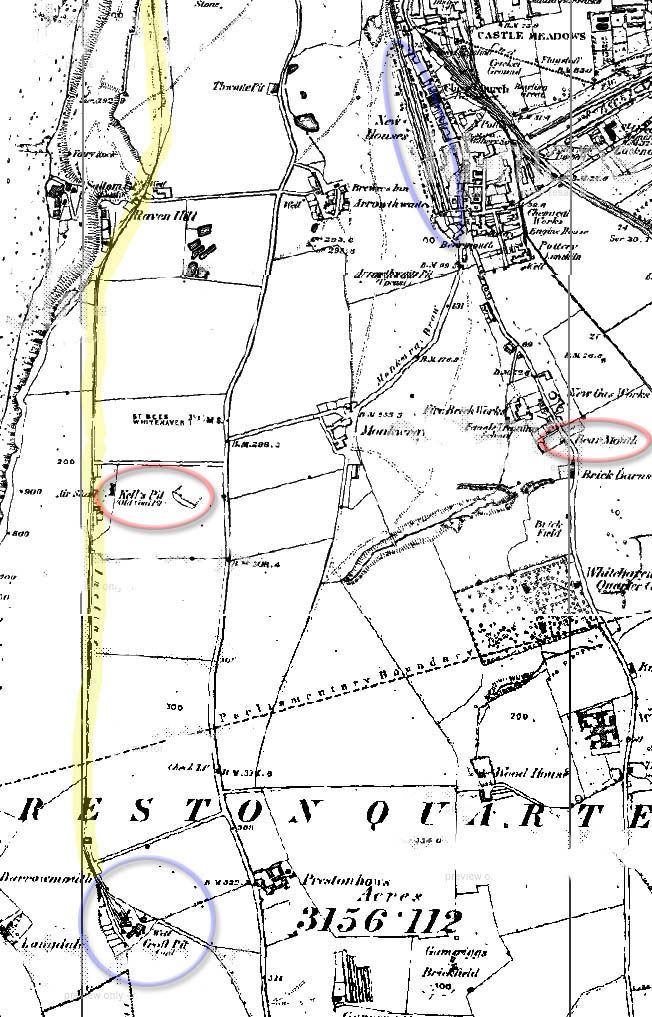
The cause of the explosion was blamed on the miners, which - even in 1828 - was condemned by the newspaper as a lame excuse.

The Davy Lamp, which had been devised by Sir Humphrey Davy in 1815, was safe to use in a mine because, as we see above, the flame was surrounded by a metal gauze which allowed air in but prevented transference of fire beyond the gauze, even if the lamp was surrounded by flammable gas. The gas in coal mines is primarily methane in modern terminology, which was called fire-damp in the newspaper article of 1828.
The problem was that the light from the lamp was considerably dimmed by the gauze. Miners - when they decided they were safe - were tempted to remove the top assembly and to work by the naked flame. Ah, much brighter! This is probably what happened in the Croft Pit... kaboom.
The newspaper says Edward was 'dreadfully burnt' but was 'expected to recover', and indeed we know that he did, though whether the poor fellow escaped disfigurement is not recorded.
So Edward, probably maimed, is back working at the mine in the early 1830s, and - just as we saw in 1802 - he's not alone. At least one other member of his family, his little brother George (b1798) whom we see in the tree below - 16 years younger than Edward - is also working as a coal miner at the Croft Pit:

Of course George would be aware of the dangers of working in a mine, after what happened to his big brother in 1828. And in any case, the mine owners would have learned their lesson and would have tightened up safety as a result of the earlier tragedy, wouldn't they?...

The above newspaper cutting is from 22 November 1831, three years after the explosion which burned Edward in the exact same mine in 1828 - Croft Pit, and was ultimately blamed on the same cause: miners misusing their Davy lamps, or - to put it another way - being permitted to misuse their Davy Lamps.
I use the photograph below to fire our imagination of the terrible scene. It's the aftermath of a coal mine explosion, but not at Croft Pit:
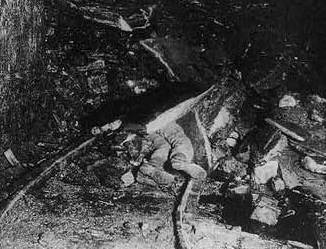
Edward would have naturally heard the news about this new explosion very quickly and no doubt his immediate reaction would be to check to see if his little brother George was all right. If that was the case, then his worst fears would have been confirmed. George Partleton was one of the 22 dead:
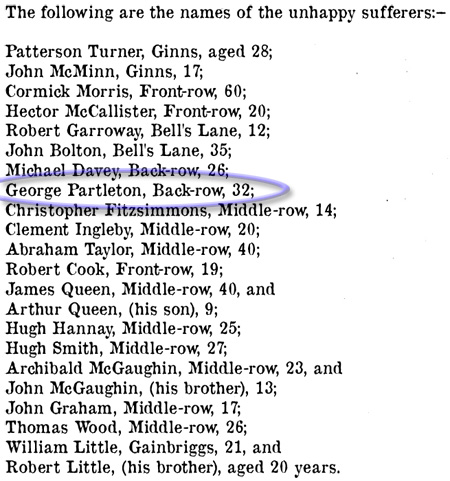
At the time of his death, George was living at Back Row - one of the New Houses where we saw Edward 22 years earlier in 1809. George's death is fully covered in his own page on the Partleton Tree.
We might also note with interest that the newspaper reports always use the name Partleton for both Edward and his brother George.
So we move on to the first full census of the UK, which was held on 06 June 1841, and we find Edward, as Edward Partington, with his wife Elizabeth and some of their children:

I'll take this opportunity to give credit to Ancestry.co.uk who provided the above census and other original records in this web site. If you're inspired by this website to seek out your own British ancestors as I have done, click here.
Check out the 'Place' name of Edward's residence. No... Edward is not living in Hell's Bearmouth, though we might think that a rather apt description. It's actually Kells Bearmouth, referring to Kells Pit which we see circled red in the map below:

Bear Mouths are horizontal entrances to coal mines by which men and horses would gain access to those forbidding coal seams in the bowels of the Earth. There were many Bear Mouths in the vicinity of Whitehaven, serving different mines. I've circled one in red in the map; it may be for the Kells Pit, or it may not. The map doesn't tell us.
The photograph below shows a 1970s excavation of a Bear Mouth in the Whitehaven area;

It's easy to see why these entrances were called Bear Mouths. What a great name.

Here's a sight which which would be very familiar to Edward as he made his way to work - the winching machinery at the top of the Kells Pit:

What we are looking at above is an early steam engine, of a type known as a beam engine, at the top of the Wreah Pit near Whitehaven. This exact same engine had, between 1792 and 1837, been used as the coal-winch at Kells Pit. The engine, built in Whitehaven, was designed by Adam Heslop and consequently is known as a Heslop Engine. Fourteen of them were deployed in the Cumberland area, but when this one was installed at Kells in 1792, it was was the very first one.
Below is another photo of the Kells Pit beam engine. Production of Heslop Engines was finally halted when James Watt successfully proved that they were a breach of the patent for his famous steam engine.

By the 1880s this Heslop Engine was already an antique and was sent to the Science Museum:

If you really want to connect with your Cumberland Partleton ancestors, you can go to see this very engine - the very one used at the Kells Pit - which is still preserved in the Science Museum in London.
Now we are on the subject of mining machinery, it's time to introduce another Edward Partleton / Partington, whom we find residing on the Isle of Man in the 1841 census...
But as usual this page has rambled on too long and has become too big, so...
Click here to continue with the story of Edward Partleton
If you enjoyed reading this page, you are invited to 'Like' us on Facebook. Or click on the Twitter button and follow us, and we'll let you know whenever a new page is added to the Partleton Tree:
Do YOU know any more to add to this web page?... why not send us an email to partleton@yahoo.co.uk
Click here to return to the Partleton Tree 'In Their Shoes' Page for Cumberland